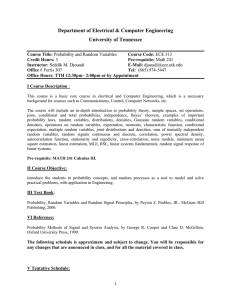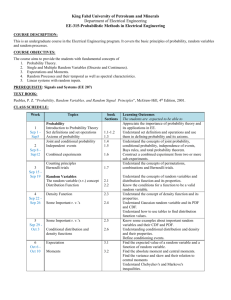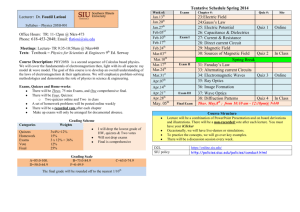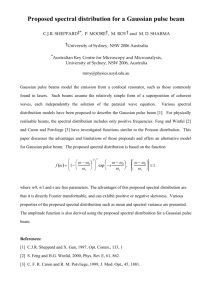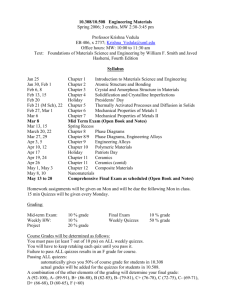Syllabus - King Fahd University of Petroleum and Minerals
advertisement
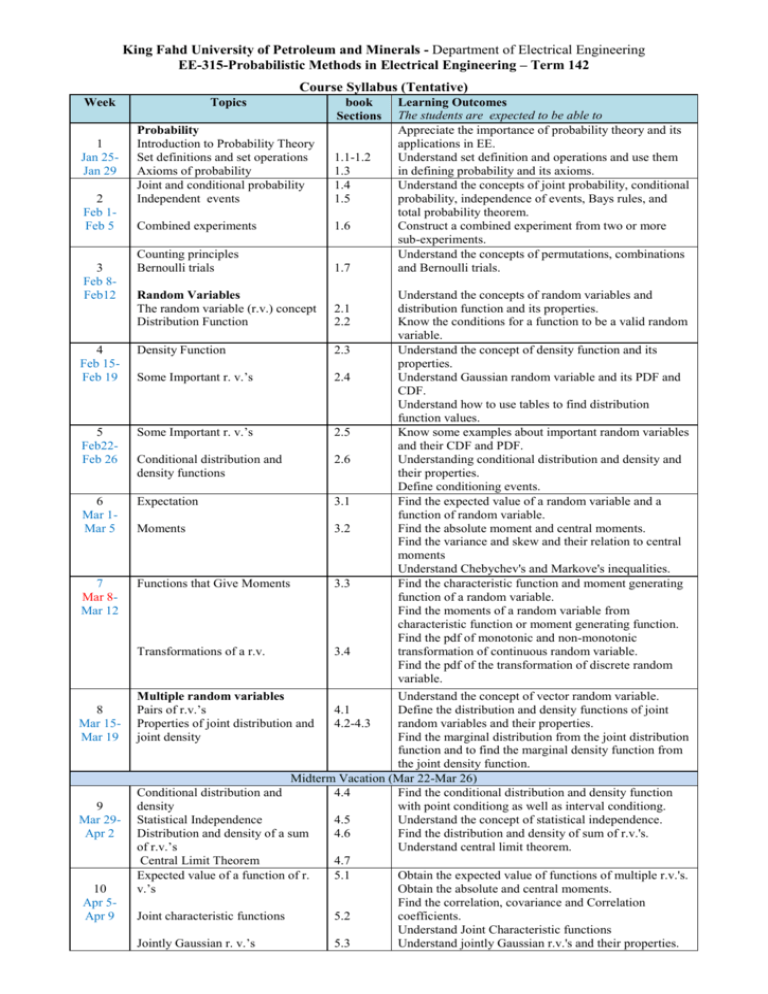
King Fahd University of Petroleum and Minerals - Department of Electrical Engineering EE-315-Probabilistic Methods in Electrical Engineering – Term 142 Course Syllabus (Tentative) Week 1 Jan 25Jan 29 2 Feb 1Feb 5 3 Feb 8Feb12 4 Feb 15Feb 19 5 Feb22Feb 26 6 Mar 1Mar 5 7 Mar 8Mar 12 8 Mar 15Mar 19 9 Mar 29Apr 2 10 Apr 5Apr 9 Topics book Sections Probability Introduction to Probability Theory Set definitions and set operations Axioms of probability Joint and conditional probability Independent events 1.1-1.2 1.3 1.4 1.5 Combined experiments 1.6 Counting principles Bernoulli trials 1.7 Learning Outcomes The students are expected to be able to Appreciate the importance of probability theory and its applications in EE. Understand set definition and operations and use them in defining probability and its axioms. Understand the concepts of joint probability, conditional probability, independence of events, Bays rules, and total probability theorem. Construct a combined experiment from two or more sub-experiments. Understand the concepts of permutations, combinations and Bernoulli trials. Understand the concepts of random variables and distribution function and its properties. Know the conditions for a function to be a valid random variable. Density Function 2.3 Understand the concept of density function and its properties. Some Important r. v.’s 2.4 Understand Gaussian random variable and its PDF and CDF. Understand how to use tables to find distribution function values. Some Important r. v.’s 2.5 Know some examples about important random variables and their CDF and PDF. Conditional distribution and 2.6 Understanding conditional distribution and density and density functions their properties. Define conditioning events. Expectation 3.1 Find the expected value of a random variable and a function of random variable. Moments 3.2 Find the absolute moment and central moments. Find the variance and skew and their relation to central moments Understand Chebychev's and Markove's inequalities. Functions that Give Moments 3.3 Find the characteristic function and moment generating function of a random variable. Find the moments of a random variable from characteristic function or moment generating function. Find the pdf of monotonic and non-monotonic Transformations of a r.v. 3.4 transformation of continuous random variable. Find the pdf of the transformation of discrete random variable. Understand the concept of vector random variable. Multiple random variables Pairs of r.v.’s 4.1 Define the distribution and density functions of joint Properties of joint distribution and 4.2-4.3 random variables and their properties. joint density Find the marginal distribution from the joint distribution function and to find the marginal density function from the joint density function. Midterm Vacation (Mar 22-Mar 26) Conditional distribution and 4.4 Find the conditional distribution and density function density with point conditiong as well as interval conditiong. Statistical Independence 4.5 Understand the concept of statistical independence. Distribution and density of a sum 4.6 Find the distribution and density of sum of r.v.'s. of r.v.’s Understand central limit theorem. Central Limit Theorem 4.7 Expected value of a function of r. 5.1 Obtain the expected value of functions of multiple r.v.'s. v.’s Obtain the absolute and central moments. Find the correlation, covariance and Correlation Joint characteristic functions 5.2 coefficients. Understand Joint Characteristic functions Jointly Gaussian r. v.’s 5.3 Understand jointly Gaussian r.v.'s and their properties. Random Variables The random variable (r.v.) concept Distribution Function 2.1 2.2 11 Apr 12Apr 16 12 Apr 19Apr 23 13 Apr 26April 30 14 May 3May 7 15 May 10May 14 Transformations of multiple r.v.’s 5.4 Linear transformations of Gaussian r.v.’s Sampling and some limit theorems 5.5 Random Processes –Temporal Characteristics Concept of a random process Stationary and independence Correlation functions and their properties Gaussian random process Poisson random process Random Processes – Spectral Characteristic Power Spectral Density and its properties Relationship between PSD and autocorrelation function Linear systems with random inputs Random signal response of linear systems Spectral characteristics of system response Review 5.7 6.1 6.2 6.3-6.4 6.5 6.6 7.1 7.2 8.2-8.3 8-4 Derive the density function of transformation of multiple r.v.'s. Perform a linear transformation of a set of Gaussian r.v.'s. Find the sample mean and variance. Understand the weak and strong laws of large numbers Understand the concept of random processes. Know different classes of r.p.'s Understand the concepts of stationary and independence of r.p.'s. Find the auto-correlation, auto-covariance, crosscorrelation and cross-covariance functions of r.p.'s. Understand Gaussian r.p. Understand Poisson r.p. Understand the concept of power density spectrum and its properties. Find RMS bandwidth of a r.p. Understand the relationship between PSD and autocorrelation function. Analyze LTI systems with random input in time and frequency domains. Evaluate system response and its mean, mean-squared and auto-correlation values. Evaluate power spectral density of LTI system response. HOMEWORKS: Homework is due last class in the assigned week. Homework is due during class time. Selected problems will be graded. Homework is to be solved completely by students and submitted on time. Late submissions will not be accepted. Homework solutions will be posted on Blackboard. The following are problem sets of the homework and their due dates. Additional homework may be assigned during the semester. HW # 1 HW # 2 HW # 3 HW # 4 HW # 5 HW # 6 HW # 7 HW # 8 1.1-5, 1.2-3, 1.3-7, 1.3-11, 1.4-5, 1.4-11, 15-6, 1.7-1 2.1-1, 2.1-7, 2.1-11, 2.2-5, 2.3-2, 2.3-15, 2.4-1, 2.4-6, 2.4-14, 2.5-3, 2.6-3, 3.1-11, 3.1-15, 3.2.-23, 3.2-24, 3.4-2, 3.4-10, 4.2-8, 4.2-11, 4.3-8, 4.3-11, 4.4-3, 4.5-7, 4.6-10, 5.1-4, 5.1-12, 5.1-19, 5.1-34, 5.3-4, 5.4-1, 6.3-1, 6.3-2, 6.3-3, 6.3-5, 6.3-8,6.3-23 7.1-12, 7.1-16, 7.1-22, 7.2-3, 7.2-10, 8.2-18, 8.4-8, 8.4-10, 8.4-11, Due Date: Week 3; Due Date: Week 5; Due Date: Week 7; Due Date: Week 9; Due Date: Week 11; Due Date: Week 12; Due Date: Week 14; Due Date: Week 15. INSTRUCTOR: Dr. Saad Al-Abeedi OFFICE LOCATION: EMAIL: Building 59, room 0075 alabeedi@kfupm.edu.sa PHONE # 7833 OFFICE HOURS: Sun and Tue from 11:00 to 12:00 PM. COURSE DESCRIPTION: EE 315 an undergraduate course in the Electrical Engineering program. It covers the basic principles of probability, random variables and random processes. COURSE OBJECTIVES: The course aims to provide the students with fundamental concepts of 1. Probability Theory. 2. Single and Multiple Random Variables (Discrete and Continuous). 3. Expectations and Moments. 4. Random Processes and their temporal as well as spectral characteristics. 5. Linear systems with random inputs. PREREQUISITE: Signals and Systems (EE 207) TEXT BOOK: Peebles, P. Z. “Probability, Random Variables, and Random Signal Principles”, McGraw-Hill, 4th Edition, 2001. REFERENCES: Leon-Garcia, A. “Probability and Random Processes for EE”, Addison Wesley, 2nd Edition, 1994. Ross, S. . “A First Course in Probability”, Prentice Hall, Fifth Edition, 1998. Helstrom, C.W. “Probability and Stochastic Processes for Engineers”, Addison-Wesley, 2nd Edition, 1992. Walpole, R.E., et al.., “Probability and Statistics for Engineers and Scientists”, Prentice Hall, Sixth Edition, 1998. POLICIES: I. GRADING POLICY: Quizzes 15% Class work 25% Assignments and Projects 10% Major 1 20% Exams 75% Major 2 20% Final 35% II. EXAMS AND QUIZZES: All students must attend the scheduled exams and quizzes on time and there will be no makeups. Major exams and final will be coordinated. Students should make sure that they understand all the material in all selected section from the course textbook. You should do the HW by yourself. The quizzes will be related to the HW. Major 1: Sunday, Week 7, March 8, 2015, 6:30-8:00 PM Coverage up to and including Section 3.1 Major 2: Thursday, Week 12, April 23, 2015, 6:30-8:00 PM Coverage up to and including Section 6.4 III. ATTENDANCE: Students without absence will get a bonus of 5 marks. Each absence will cut 1 point from your bonus. Each late arrival will cut ½ a point from your grade. A student who comes late for more than 5 minutes will be marked as absent. According to the university regulations, any student that exceeds 20% (9 abs) of the scheduled class meeting without an official excuse will receive a grade of DN in the course. All official excuses must be submitted to the instructor no later than one week of the date of the official excuse. A late excuse may not be accepted by the instructor. IV. ACTIVE ATTENDANCE: You are expected to be an active learner, ask questions and participate in class discussions. It is absolutely prohibited to use your phone/tablet during class. Before entering the class, make sure that you switched off (or muted) your device. Reading other materials, playing with your device or chatting with others are acts of disrespecting the instructor and may result in harsh consequences. V. TO SUCCESSFULLY PASS THE COURSE WITH A NICE GRADE, I EXPECT FROM YOU TO: be on time, be honest, sincere and hardworking learner, NOT cheat or copy others work and solutions (including solution manual), be an active learner, ask questions and participate in class discussions, bring a notebook (or papers) and a pen; we will usually have exercises during class time, avoid using your mobile or any other source of distraction in the class.
